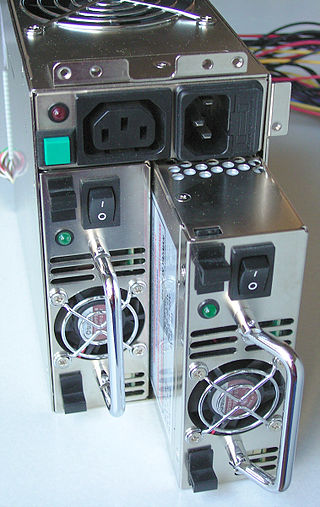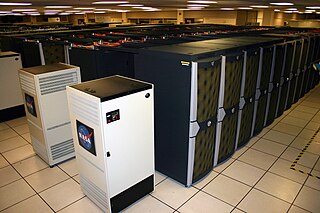Related Research Articles

In computing, load balancing is the process of distributing a set of tasks over a set of resources, with the aim of making their overall processing more efficient. Load balancing can optimize response time and avoid unevenly overloading some compute nodes while other compute nodes are left idle.
Tandem Computers, Inc. was the dominant manufacturer of fault-tolerant computer systems for ATM networks, banks, stock exchanges, telephone switching centers, 911 systems, and other similar commercial transaction processing applications requiring maximum uptime and no data loss. The company was founded by Jimmy Treybig in 1974 in Cupertino, California. It remained independent until 1997, when it became a server division within Compaq. It is now a server division within Hewlett Packard Enterprise, following Hewlett-Packard's acquisition of Compaq and the split of Hewlett-Packard into HP Inc. and Hewlett Packard Enterprise.
Checkpointing is a technique that provides fault tolerance for computing systems. It involves saving a snapshot of an application's state, so that it can restart from that point in case of failure. This is particularly important for long-running applications that are executed in failure-prone computing systems.
In systems engineering, dependability is a measure of a system's availability, reliability, maintainability, and in some cases, other characteristics such as durability, safety and security. In real-time computing, dependability is the ability to provide services that can be trusted within a time-period. The service guarantees must hold even when the system is subject to attacks or natural failures.
A Byzantine fault is a condition of a system, particularly a distributed computing system, where a fault occurs such that different symptoms are presented to different observers, including imperfect information on whether a system component has failed. The term takes its name from an allegory, the "Byzantine generals problem", developed to describe a situation in which, to avoid catastrophic failure of a system, the system's actors must agree on a strategy, but some of these actors are unreliable in such a way as to cause other (good) actors to disagree on the strategy and they may be unaware of the disagreement.
Lockstep systems are fault-tolerant computer systems that run the same set of operations at the same time in parallel. The redundancy (duplication) allows error detection and error correction: the output from lockstep operations can be compared to determine if there has been a fault if there are at least two systems, and the error can be automatically corrected if there are at least three systems, via majority vote. The term "lockstep" originates from army usage, where it refers to synchronized walking, in which marchers walk as closely together as physically practical.

In engineering and systems theory, redundancy is the intentional duplication of critical components or functions of a system with the goal of increasing reliability of the system, usually in the form of a backup or fail-safe, or to improve actual system performance, such as in the case of GNSS receivers, or multi-threaded computer processing.
Fault tolerance is the ability of a system to maintain proper operation despite failures or faults in one or more of its components. This capability is essential for high-availability, mission-critical, or even life-critical systems.
Reliability, availability and serviceability (RAS), also known as reliability, availability, and maintainability (RAM), is a computer hardware engineering term involving reliability engineering, high availability, and serviceability design. The phrase was originally used by IBM as a term to describe the robustness of their mainframe computers.
Replication in computing refers to maintaining multiple copies of data, processes, or resources to ensure consistency across redundant components. This fundamental technique spans databases, file systems, and distributed systems, serving to improve availability, fault-tolerance, accessibility, and performance. Through replication, systems can continue operating when components fail (failover), serve requests from geographically distributed locations, and balance load across multiple machines. The challenge lies in maintaining consistency between replicas while managing the fundamental tradeoffs between data consistency, system availability, and network partition tolerance – constraints known as the CAP theorem.
High availability (HA) is a characteristic of a system that aims to ensure an agreed level of operational performance, usually uptime, for a higher than normal period.
In computer science, state machine replication (SMR) or state machine approach is a general method for implementing a fault-tolerant service by replicating servers and coordinating client interactions with server replicas. The approach also provides a framework for understanding and designing replication management protocols.
Paxos is a family of protocols for solving consensus in a network of unreliable or fallible processors. Consensus is the process of agreeing on one result among a group of participants. This problem becomes difficult when the participants or their communications may experience failures.
A clustered file system (CFS) is a file system which is shared by being simultaneously mounted on multiple servers. There are several approaches to clustering, most of which do not employ a clustered file system. Clustered file systems can provide features like location-independent addressing and redundancy which improve reliability or reduce the complexity of the other parts of the cluster. Parallel file systems are a type of clustered file system that spread data across multiple storage nodes, usually for redundancy or performance.
In quantum computing, the threshold theorem states that a quantum computer with a physical error rate below a certain threshold can, through application of quantum error correction schemes, suppress the logical error rate to arbitrarily low levels. This shows that quantum computers can be made fault-tolerant, as an analogue to von Neumann's threshold theorem for classical computation. This result was proven by the groups of Dorit Aharanov and Michael Ben-Or; Emanuel Knill, Raymond Laflamme, and Wojciech Zurek; and Alexei Kitaev independently. These results built on a paper of Peter Shor, which proved a weaker version of the threshold theorem.

A computer cluster is a set of computers that work together so that they can be viewed as a single system. Unlike grid computers, computer clusters have each node set to perform the same task, controlled and scheduled by software. The newest manifestation of cluster computing is cloud computing.

A single point of failure (SPOF) is a part of a system that, if it fails, will stop the entire system from working. SPOFs are undesirable in any system with a goal of high availability or reliability, be it a business practice, software application, or other industrial system. If there is a SPOF present in a system, it produces a potential interruption to the system that is substantially more disruptive than an error would elsewhere in the system.
A distributed operating system is system software over a collection of independent software, networked, communicating, and physically separate computational nodes. They handle jobs which are serviced by multiple CPUs. Each individual node holds a specific software subset of the global aggregate operating system. Each subset is a composite of two distinct service provisioners. The first is a ubiquitous minimal kernel, or microkernel, that directly controls that node's hardware. Second is a higher-level collection of system management components that coordinate the node's individual and collaborative activities. These components abstract microkernel functions and support user applications.
Software fault tolerance is the ability of computer software to continue its normal operation despite the presence of system or hardware faults. Fault-tolerant software has the ability to satisfy requirements despite failures.

Quasi-opportunistic supercomputing is a computational paradigm for supercomputing on a large number of geographically disperse computers. Quasi-opportunistic supercomputing aims to provide a higher quality of service than opportunistic resource sharing.
References
- 1 2 Tanenbaum, Andrew S. and Maarten van Steen, Distributed Systems: Principles and Paradigms, Prentice Hall, Second Edition, 2007. ISBN 0-13-239227-5